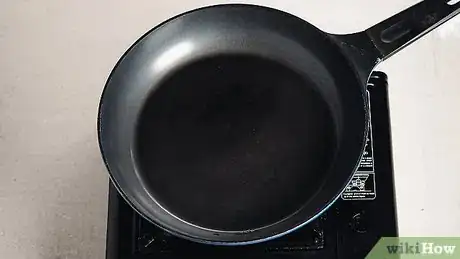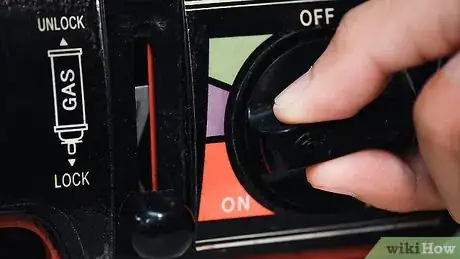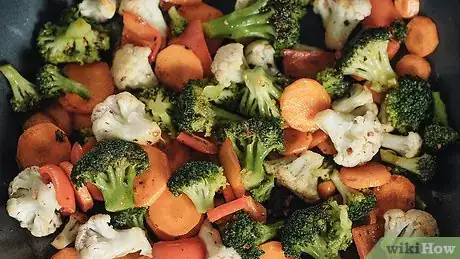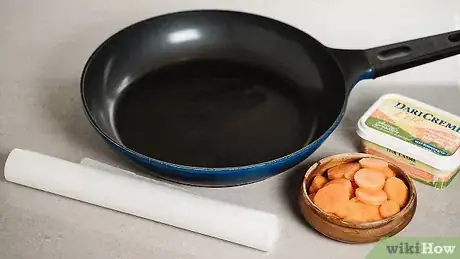This article was co-authored by Abyssinia Campbell. Abyssinia Campbell is an Executive Chef and the Owner of Chef Abyssinia, Personal Chef and Catering. With over ten years of experience, she specializes in catering, event planning, menu development, meal planning, and food business operations. When it comes to cooking, Chef Abyssinia enjoys using fruits, vegetables, healthy food alternatives, and local farm-fresh ingredients. She holds a BASc in Culinary Arts and Food Service Management from Johnson and Wales University.
There are 9 references cited in this article, which can be found at the bottom of the page.
This article has been viewed 541,160 times.
Sautéing is way to pan-fry vegetables using a small amount of fat. It cooks the vegetables in such a way that they remain firm and retain their integrity and nutritional content, while still being cooked all the way through. Sautéed vegetables are a quick, healthy and colorful dish that can be added to lunch or dinner or even served a la carte.
Steps
Getting the Vegetables and Pan Ready
-
1Cut the vegetables. The first step is to prepare the vegetables by cutting them into uniform bite-sized pieces. Remove any stems and discolored areas during this process.[1] Do your best to make the pieces the same size.[2]
- If your vegetables are not the same size (and especially the same thickness), they won't finish cooking at the same time. When you take your vegetables out of the pan, some will either be over or under-cooked.
-
2Choose the right pan. In theory, you can sauté vegetables in any pan, but some work better than others. A wide sauté pan with straight sides or a skillet with sloped sides works best.[3]
- Your pan should have a dense bottom so as to distribute heat evenly.
- A stainless steel, non-stick, aluminum, or anodized pan will work well.
- For dense vegetables like potatoes and cabbage, cast iron works well because it holds and evenly distributes heat.
Advertisement -
3Add oil or fat. Choose an oil or fat to sauté your vegetables in. Butter or any kind of oil will work. You can also use bacon fat, though this option is less healthy.
- While any oil will work, oils with a high smoke-point such as canola oil, peanut oil, and regular olive oil work best. Oils with a lower smoke point like extra virgin olive oil nut-infused oils can be used, but often lose their flavor when cooked at high temperatures.[4]
- If you choose to sauté in butter, adding a tablespoon of oil to the pan will help keep the butter from smoking and burning.
-
4Heat the pan. Turn your burner up to medium-high and allow the pan and oil to heat up.[5]
Cooking the Vegetables
-
1Wait for oil to shimmer. When the oil shimmers, it is hot enough to cook your vegetables.[6] If you put them in before this, the oil won't be hot enough to brown them, and they may stick to the bottom of the pan.
- In adequate light, hot oil will become iridescent and colorful. When it takes on these characteristics, it's ready.
-
2Add flavoring ingredients. If you are adding spicy ingredients like garlic or hot peppers, it's usually a good idea to add them first, as they will impart some of their flavor to the oil.
- Minced garlic typically should be added one minute before the other vegetables.[7]
- Hot peppers like jalapeños can be added five minutes before the other vegetables.[8]
- Since garlic cooks quickly and burns easily, you want to sauté it first, letting it get to a light brown color. Remove it from the pan before adding your other vegetables, then return it to the pan right as the other veggies finish cooking.
-
3Add your vegetables. Don't overcrowd the pan. You can cover the bottom, but you don't want more than one layer of vegetables.[9]
- If the vegetables are piled on top of each other, the steam from the lower vegetables may become trapped. The result can be steamed vegetables rather than sautéed ones.
- If you have too many vegetables to fit in the pan without overcrowding, cook them in two or more batches.
-
4Toss or stir. Turn your vegetables frequently by tossing or stirring them. This ensures even cooking on all sides.[10]
- You should not stir constantly, as you would with a stir-fry. A few stirs should do the trick, depending on how long the vegetables need to cook.
-
5Cook until done. How long this takes will depend on the type of vegetables. Between three and ten minutes is typical, but you'll probably need to experiment some to get this right. [11] Keep in mind that vegetables shouldn't get soggy.
- Vegetables with the longest cooking times include carrots, onions, and hearty greens like collards. These can take 10-15 minutes. Potatoes can take even longer, and some people simmer them in water first to make them sauté more quickly. Covering your pot with a lid for the first few minutes may help speed up the process.[12]
- Vegetables with medium cooking times include broccoli, cauliflower, bell peppers, and Brussels sprouts. These can take eight to 10 minutes. You can shorten the cook time, though, by placing these veggies in the pan with a few tablespoons of water before adding the oil. Wait for the water to evaporate, then add the oil and continue cooking.
- Vegetables with short cooking times include mushrooms, corn, tomatoes, and asparagus. These can cook in as little as two minutes.
- Spinach and other greens have the shortest cooking times, as they will quickly wilt. A minute or two should do it.
- If you are cooking vegetables with different cooking times in the same pan, add the ones that need to be cooked longest first, let them cook partially, and then add the vegetables that require less cooking time. Or, cook individually and then mix.
-
6Season as desired. Right before the vegetables are done, add any seasonings you wish to include. This could include salt and pepper, soy sauce, citrus juice, vegetable stock, oregano, or other dried herbs.[13]
- Ingredients such as these should generally be in the pan for about one minute.
-
7Remove from pan. When vegetables are done, remove from the pan quickly to avoid overcooking. Serve and enjoy!
- If you wish, you can add some fresh herbs before serving.
Using Parchment Paper
-
1Prepare vegetables and pan. An alternative way to sauté vegetables, for an especially tender texture, is to use a piece of parchment paper. For this variation, cut the vegetables and heat the pan as normal[14]
- Use a pat of butter for your cooking fat.
-
2Add water and vegetables. Next, add just a small splash of water, salt and pepper, and your vegetables. Again, be careful not to overcrowd the pan.
-
3Cover with parchment paper. Cover the pan loosely with a piece of parchment paper. Check the vegetables regularly. Wait for the water to evaporate.
-
4Remove parchment and caramelize. When the water has evaporated, remove the parchment and cook for a couple more minutes, allowing the butter to caramelize the vegetables.
Community Q&A
-
QuestionWhat is the maximum cooking time?
 Community AnswerThis depends on the vegetables you've added, and how large the pieces are. Keep an eye on the skillet and remove when the veggies have darkened in color and are tender--usually 5 to 10 minutes works well.
Community AnswerThis depends on the vegetables you've added, and how large the pieces are. Keep an eye on the skillet and remove when the veggies have darkened in color and are tender--usually 5 to 10 minutes works well. -
QuestionWhy do the vegetables not stick together in a ball? What should be added to make them stick together?
 Maggie PetersonCommunity AnswerThe vegetables do not stick together because they are cooked with oil and fat, which makes them slippery. If you don't add oil or fat, the vegetables will stick to the pan and burn. You cannot sauté vegetables without them falling apart.
Maggie PetersonCommunity AnswerThe vegetables do not stick together because they are cooked with oil and fat, which makes them slippery. If you don't add oil or fat, the vegetables will stick to the pan and burn. You cannot sauté vegetables without them falling apart.
Warnings
- Be careful not to burn yourself with the hot oil. It may sputter and shoot small drops of oil from the pan, especially when you add the vegetables.⧼thumbs_response⧽
References
- ↑ http://www.webmd.com/diet/healthy-kitchen-11/best-cook-vegetables
- ↑ http://www.cookinglight.com/cooking-101/techniques/10-sauteing-tips
- ↑ http://www.cookinglight.com/cooking-101/techniques/10-sauteing-tips
- ↑ http://www.cookinglight.com/cooking-101/techniques/10-sauteing-tips
- ↑ https://www.foodnetwork.com/recipes/sauteed-vegetables-recipe0-1947078
- ↑ http://www.webmd.com/diet/healthy-kitchen-11/best-cook-vegetables
- ↑ http://www.foodnetwork.com/recipes/sauteed-vegetables-recipe0.html
- ↑ http://allrecipes.com/recipe/232941/garlic-vegetable-saute/
- ↑ http://www.cookinglight.com/cooking-101/techniques/10-sauteing-tips
- ↑ http://www.cookinglight.com/cooking-101/techniques/10-sauteing-tips
- ↑ http://www.thekitchn.com/how-long-to-cook-vegetables-a-beginners-guide-to-preparation-times-171231
- ↑ http://www.bbcgoodfood.com/recipes/2832/perfect-sauted-potatoes
- ↑ http://www.foodnetwork.com/recipes/sauteed-vegetables-recipe0.html
- ↑ http://skillet.lifehacker.com/saute-vegetables-to-tenderness-without-overcooking-them-1709408294
- Videos provided by Chowhound
About This Article
To sauté vegetables, start by heating some oil in a pan over a stovetop. When the oil starts to shimmer, add your vegetables to the pan and stir them so they're completely coated in oil. Then, spread the vegetables out in an even layer and let them cook over medium-high heat for 10-15 minutes. When the vegetables are done cooking, sprinkle your favorite seasonings on them and serve! If you want to learn how to use parchment paper while sautéing your vegetables, keep reading the article!




















































